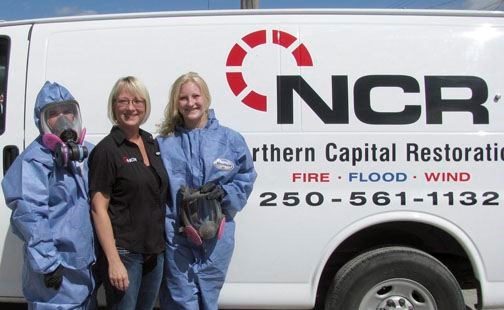Fingerprint powder is a bugger to clean. So are a lot of other things related to a crime scene.
Take a step past the gory details of violent crime and think about what kind of aftermath can be left in a home and how devastating that can be to family left behind.
Most people have already been emotionally overwhelmed by the event. They shouldn't be traumatized further trying to deal with the cleanup, said Tania Lienert, co-owner with Chris Brown of Northern Capital Restorations (NCR). The company has been doing the job for about 14 years and has had a division in Chetwynd for about four years.
"Typically when it's a murder or suicide trauma scene clean up - biohazard clean up - the first thing you have to worry about is the emotional needs of the family," said Lienert. "You have to be extremely compassionate and sensitive and you have to handle the scene very discreetly. Nobody wants the neighbourhood to know what's happened." And discretion is needed for resale purposes as well, Lienert added. Some people need to be able to leave the home behind after a tragedy.
"How the work potentially comes to us is through Victim Services, RCMP and insurance companies," said Lienert. The Red Cross also calls them in for jobs like the Victoria Towers fire, the Connaught residents flood and the Westwood fire.
When NCR gets to a home after a murder or suicide, the coroner and the RCMP have already completed their investigation.
"Now we need to clean it up," said Lienert.
"First thing we do is interview the family or their representative. It's extremely shocking when these things happen. But it's not always unexpected. Usually if it's a suicide the family has had to deal with the person's mental health issues or drug addiction for years. Even if it's a murder, there's usually a background to those stories as well."
So Lienert will ask if there are things in the room affected - in most cases a bedroom - that the family wants to keep for sentimental reasons. Some people will say get rid of all of it. Others will ask Lienert to recover certain items in any condition. Lienert's team will do their best to restore and sanitize the keepsakes as best they can.
Suicide by a drug addicted person, Lienert said, unless it's an overdose, is always a violent death in her experience.
"For the most part the suicide happens because the person is hallucinating and they think they are being attacked and someone is out to get them and they are protecting themselves. They are very violent because they are in a state of panic," said Lienert, casting her eyes to the carpet. "So those ones are a little bit harder."
With a deep breath, Lienert carries on.
"Let's say a shotgun was used," said Lienert. "Then you have the biohazards to deal with."
Biohazards include tissue matter, blood and bone fragment. Drywall, carpet and underlay must be removed, furniture discarded, she explained.
"It all has to be done as biowaste," said Lienert.
The big picture of the process starts with a lined waste management bin that is delivered to the house. Ideally the room beside the affected room is a transfer room that is contained in plastic sheeting, where all discarded items are brought, sealed in plastic and put into the bio matter bin, Lienert explained.
Staff would don and doff their personal protective equipment when entering and exiting the house so as not to alert the neighbours there is a biohazards removal taking place in the home, Lienert said.
The equipment includes a disposable suit, booties, puncture resistant gloves and a full or half face mask, depending on the level of odours in the room.
"We have a crew of two that is extremely good at it now, we've done it enough times and we have one gentleman here - he can handle anything," said Lienert.
There are different aspects to the cleaning. If it's a crime scene and the RCMP have dusted for fingerprints, there will be powder residue on many surfaces that is difficult to remove.
"It's a real bugger to get clean but we have a cleaner to get that out," Lienert said. "So we will go through the home and do a full clean so that the family doesn't have to come home and see the fingerprint residue over everything, that's just another upsetting aspect to it so we take care of all of that."
There is also unattended death where someone has passed away and no one has discovered the body for a couple of weeks.
"Those ones are gucky," said Lienert. "So what happens in those cases is the coroner goes in and removes the body."
A body that has decomposed for that long leaves a very strong odour, Lienert said.
"So even though the source has been removed, the odour permeates the whole home or apartment," said Lienert. Even when the bed or chair the person died in or the carpet the person may have fallen onto has been removed.
"We have to do a full clean, and then deodourize," said Lienert. The technique used is called ozone deodourization where the area is completely sealed off during the procedure.
The next step for restoration includes sanitization.
"Let's say fluids went through the carpet, underpad and soaked into the concrete," said Lienert.
"We would clean and sanitize the concrete and encapsulate the concrete."
NCR uses a special sealant that blocks odours.
"And covers any staining, which is important visually," said Lienert.
"And then we put it back together. We reinsulate, re-drywall, paint and trim and flooring and we probably do between five and eight a year."


.png;w=120;h=80;mode=crop)
